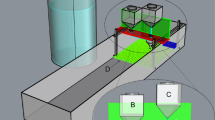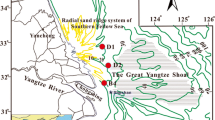Abstract
Estuarine turbidity maxima (ETM) retain suspended particulate matter (SPM) through advection, settling, aggregation, and nonlinearities in bed processes, but the relative importance of these processes varies strongly between systems. Observations from two strongly advective systems (the Columbia and Fraser Rivers) are used to investigate seasonal cycles of SPM retention and the effects of very high flows. Results for the Fraser and Columbia plus literature values for 13 other estuaries illustrate the applicability of scaling parameters and the response of ETM phenomena to a range of river flow (U r ) levels and tidal forcing. The most efficient trapping (represented by Trapping EfficiencyE, the ratio of maximum ETM concentration to the source SPM concentration) occurs for low ratios of river flow to tidal current amplitude (UT), represented by low values of the Supply number Sr.E in the Columbia is found to be maximal in a null zone where advection or tidal asymmetry (represented by Advection numberA) is weak(A ∼ 0). The ratio of aggregation to disaggregation (the Floc number Θ) is maximal on neap tides, while the ratio of erosion to deposition (the Erosion number P) is maximal on spring tides. The ratio of settling velocity to vertical mixing (Rouse numberP) is relatively constant in the Columbia ETM(P ∼ 0.7), because particle settling velocity and turbulence levels adjust together. Assuming that this result applies broadly, scaling variables and data are combined to express ETM properties in terms of the friction velocity (U*),U r , andU T , allowing a considerable simplification of the parameters used to describe ETM.
Similar content being viewed by others
Literature Cited
Allen, G. P., G. Sauzay, P. Castaing, andJ. M. Jouanneau. 1977. Transport and deposition of suspended sediment in the Gironde Estuary, France, p. 63–81.In M. Wiles (ed.), Estuarine Processes. Academic Press, New York.
Bottom, D. L., C. A. Simenstad, J. Burke, A. M. Baptista, D. A. Jay, K. K. Jones, E. Casillas, and M. H. Schiewe. 2005. Salmon at river’s end: The role of the estuary in the decline and recovery of Columbia River salmon. U.S. Department of Commerce, National Oceanic and Atmospheric Administration Technical Memorandum NMFS-NWFSC-68, final report. Seattle, Washington.
Chisholm, T. A. 1999. A two-component aggregation model. Ph.D. Dissertation, College of William and Mary, Williamsburg, Virginia.
Church, M. andD. G. McLean. 1994. Sedimentation in lower Fraser River, British Columbia: Implications for Management, p. 221–241.In S. Schumm and B. Winkley (eds.), Variability in Large Alluvial Rivers. American Society of Civil Engineers Press, New York.
Crump, B. C., E. V. Armbrust, andJ. A. Baross. 1999. Phylogenetic analysis of particle-attached and free-living bacterial communities in the Columbia River, estuary and adjacent coastal ocean.Applied Environmental Microbiology 65:3192–3204.
Crump, B. C., J. A. Baross, andC. A. Simenstad. 1998. Dominance of particle-attached bacteria in the Columbia River estuary.Aquatic Microbiology and Ecology 14:7–18.
Fain, A. M. V. 2000. Suspended particulate dynamics in the Columbia River Estuary. M.S. Thesis, Oregon Health and Science University, Beaverton, Oregon.
Fain, A. M. V., D. A. Jay, D. J. Wilson, P. M. Orton, andA. M. Baptista. 2001. Seasonal, monthly and tidal patterns of particulate matter dynamics in a stratified estuary.Estuaries 24:770–786.
Fugate, D. C. AND C. T. Friedrichs. 2002. Determining concentration and fall velocity of estuarine particle populations using ADV, OBS, and LISST.Continental Shelf Research 22:1867–1886.
Gelfenbaum, G. 1983. Suspended-sediment response to semidiurnal and fortnightly tidal variations in a mesotidal estuary: Columbia River, U.S.A.Marine Geology 52:39–57.
Geyer, W. R. 1995. Final Report: Particle Trapping in the Lower Hudson Estuary. Hudson River Foundation, New York.
Geyer, W. R. andD. M. Farmer. 1989. Tide induced variation of the dynamics of a salt wedge estuary.Journal of Physical Oceanography 28:1060–1072.
Geyer, W. R., R. P. Signell, and G. C. Kineke. 1997. Lateral trapping of sediment in a partially mixed estuary.In 8th International Biennial Conference on Physics of Estuaries and Coastal Seas, 1996. A. A. Balkema, Rotterdam, The Netherlands.
Giese, B. S. andD. A. Jay. 1989. Modeling tidal energetics of the Columbia River estuary.Estuarine Coastal and Shelf Science 29: 549–571.
Grabemann, I., J. Kappenberg, andG. Krause. 1996. Comparison of the dynamics of the turbidity maxima in two coastal plain estuaries.Advances in Limnology 47:195–205.
Grabemann, I. andG. Krause. 1989. Transport processes of suspended matter derived from time series in a tidal estuary.Journal of Geophysical Research 94:14373–14379.
Grabemann, I. andG. Krause. 2001. On different time scales of suspended matter dynamics in the Weser Estuary.Estuaries 24: 688–698.
Grabemann, I., R. J. Uncles, G. Krause, andJ. A. Stephens. 1997. Behaviour of turbidity maxima in the Tamar (U.K.) and Weser (F.R.G.) estuaries.Estuarine Coastal and Shelf Science 45: 235–246.
Green, M. O., R. G. Bell, T. J. Dolphin, andA. Sales. 2000. Silt and sand transport in a deep tidal channel of a large estuary (Manukau Harbour, New Zealand).Marine Geology 163:217–240.
Hamblin, P. F. 1989. Observations and model of sediment transport near the turbidity maximum of the Upper Saint Lawrence Estuary.Journal of Geophysical Research 94:14419–14428.
Haushild, W. L., R. W. Perkins, H. H. Stevens, G. R. Dempster, andJ. L. Glenn. 1966. Radionuclide Transport in the Pasco to Vancouver, Washington Reach of the Columbia River July 1962 to September 1963. U.S. Geological Survey Open File, Portland, Oregon.
Hill, P. S., A. R. M. Nowell, andP. A. Jumars. 1992. Encounter rate by turbulent shear of particles similar in diameter to the Kolmagorov scale.Journal of Marine Research 50:643–668.
Jay, D. A., W. R. Geyer, andD. R. Montgomery. 2000. An ecological perspective on estuarine classification, p. 149–175.In J. Hobbie (ed.), Estuarine Synthesis. A Synthetic Approach to Research and Practice. Island Press, Washington, D.C.
Jay, D. A. andJ. D. Musiak. 1994. Particle trapping in estuarine turbidity maxima.Journal of Geophysical Research 99:20,446–20,461.
Jay, D. A. andJ. D. Musiak. 1996. Internal tidal asymmetry in channel flows: Origins and consequences, p. 219–258.In C. Pattiaratchi (ed.), Mixing Processes in Estuaries and Coastal Seas. American Geophysical Union, Coastal and Estuarine Sciences Monograph, Washington, D.C.
Jay, D. A. and P. Naik. 2002. Separating human and climate impacts on Columbia River hydrology and sediment transport, p. 38–48.In G. Gelfenbaum and G. Kaminsky (eds.), Southwest Washington Coastal Erosion Workshop Report 2000. U.S. Geological Survey Open File Report, 02-229. Menlo Park, California.
Jay, D. A., P. M. Orton, and T. Chisholm. 2002. Controls on the efficiency of estuarine particle trapping: Ecosystem implications. EOS Transactions American Geophysical Union 83 Abstract OS21D-09. Washington, D.C.
Jay, D. A., P. M. Orton, T. Chisholm, D. J. Wilson, andA. M. V. Fain. 2007. Particle Trapping in Stratified Estuaries: Consequences of Mass Conservation.Estuaries and Coasts 30:1096–1106.
Jay, D. A. andJ. D. Smith. 1990. Circulation, density distribution and neap-spring transitions in the Columbia River estuary.Progress in Oceanography 25:81–112.
Jilan, S. andW. Kangshan. 1986. The suspended sediment balance in Changjiang estuary.Estuarine Coastal and Shelf Science 23:81–98.
Kay, D. J. andD. A. Jay. 2003. Interfacial mixing in a highlystratified estuary. 1. Characteristics of Mixing.Journal of Geophysical Research 108:3072 doi 10.1029/2002 JC000252.
Kay, D. J., D. A. Jay, andJ. D. Musiak. 1996. Salt transport through an estuarine cross-section calculated from moving vessel ADCP and CTD data, p. 195–212.In C. Pattiaratchi (ed.), Buoyancy Effects on Coastal and Estuarine Dynamics, Volume 50, Coastal and Estuarine Studies. American Geophysical Union, Washington, D.C.
Knowles, S. C. andJ. T. Wells. 1998. In situ aggregate analysis camera (ISAAC): A quantitative tool for analyzing fine-grained suspended material.Limnology and Oceanography 43:1954–1962.
Kostachuk, R. A., J. L. Lutenauer, andM. A. Church. 1989. Suspended sediment hysteresis in a salt-wedge estuary, Fraser River, Canada.Marine Geology 87:273–285.
Kranck, K., E. Pettigrew, T. G. Milligan, andI. G. Droppo. 1993. In situ particle size distributions resulting from flocculation of suspended sediment, p. 60–74.In A. J. Mehta (ed.), Nearshore and Estuarine Cohesive Sediment Transport, Volume 42, Coastal and Estuarine Studies. American Geophysical Union, Washington, D.C.
Le Hir, P., Ph. Bassoullet, andH. Jestin. 2001. Application of the continuous modeling concept to simulate high concentration suspended sediment in a macrotidal estuary, p. 229–248.In W. H. McAnally and A. J. Mehta (eds.), Coastal and Estuarine Fine Sediment Processes, Volume 3. Elsevier, Amsterdam, The Netherlands.
Lee, H. T. andD. M. Haines. 1995. Direct inversion method to measure the concentration profile of suspended particles using backscattered sound.Journal of Geophysical Research 100:2649–2657.
Lynch, J. F. andY. C. Agrawal. 1991. A model-dependent method for inverting vertical profiles of scattering to obtain size spectra in boundary layers.Marine Geology 99:387–401.
Meade, R. H. 1972. Transport and deposition of sediments in estuaries.Geological Society of American Memoirs 133:91–120.
Orton, P. M. andG. C. Kineke. 2001. Comparing calculated and observed vertical suspended sediment distributions from a Hudson River estuary turbidity maximum.Estuarine Coastal and Shelf Science 52:401–410.
Orton, P. M., D. Wilson, D. A. Jay, and A. M. V. Fain. 2002. High resolution sediment dynamics in salt-wedge estuaries, p. 61–67.In G. Gelfenbaum and G. Kaminsky (eds.), Southwest Washington Coastal Erosion Workshop Report 2000. U.S. Geological Survey Open File Report, 02-229. Menlo Park, California.
Partheneides, E. 1993. Turbulence, flocculation and cohesive sediment dynamics, p. 40–59.In A. J. Mehta (ed.), Nearshore and Estuarine Cohesive Sediment Transport, Volume 42, Coastal and Estuarine Studies. American Geophysical Union, Washington, D.C.
Reed, D. J. andJ. Donovan. 1995. The character and composition of the Columbia River estuarine turbidity maximum, p. 445–450.In K. Dyer and R. Orth (eds.), Changing Particle Fluxes in Estuaries: Implications from Science to Management, EC-SAERF22 Symposium. Olsen and Olsen Press, Friedensborg, Denmark.
Sanford, L. P., S. E. Suttles, andJ. P. Halka. 2001. Reconsidering the physics of the Chesapeake Bay estuarine turbidity maximum.Estuaries 24:655–669.
Schubel, J. R., R. E. Wilson, andA. Okubo. 1978. Vertical transport of suspended sediment in upper Chesapeake Bay, p. 161–176. InB.J. Kjerfve (ed.), Estuarine Transport Processes, Volume 7, Library in Marine Science. University of South Carolina Press, Columbia, South Carolina.
Sherwood, C. R., D. A. Jay, R. B. Harvey, P. Hamilton, andC. A. Simenstad. 1990. Historical changes in the Columbia river estuary.Progress in Oceanography 25:271–297.
Simenstad, C. A., D. A. Jay, andC. R. Sherwood. 1992. Impacts of watershed management on land-margin ecosystems: The Columbia River estuary as a case study, p. 266–230.In R. Naimen (ed.), New Perspectives for Watershed ManagementBalancing Long-term Sustainability with Cumulative Environmental Change. Springer-Verlag, New York.
Simenstad, C. A., D. Reed, D. A. Jay, F. Prahl, L. Small, andJ. A. Baross. 1995. LMER in the Columbia River estuary: An interdisciplinary approach to investigating couplings between hydrological, geochemical and ecological processes, p. 437–444.In K. R Dyer and R. J. Orth (eds.), Changing Particle Fluxes in Estuaries: Implications from Science to Management. Olsen and Olsen Press, Friedensborg, Denmark.
Small, L. F., C. D. McIntire, K. B. MacDonald.,J. R. Lara-Lara, B. E. Frey, M. C. Amspoker, andT. Winfield. 1990. Primary production, plant and detrital biomass, and particle transport in the Columbia River estuary.Progress in Oceanography 25:175–210.
Sternberg, R. W., I. Berhane, andA. S. Ogston. 1999. Measurement of size and settling velocity of suspended aggregates on the northern California continental shelf.Marine Geology 154:43–53.
Uncles, R. J., J. Lavender, andJ. A. Stephens. 2001. Remotely sensed observations of the turbidity maximum in the highly turbid Humber Estuary, U.K.Estuaries 24:745–755.
Uncles, R. J. andJ. A. Stephens. 1993. Nature of the turbidity maximum in the Tamar Estuary, U.K.Estuarine Coastal and Shelf Science 36:413–431.
Thevenot, M. andN. C. Kraus. 1993. Comparison of acoustical and optical measurements of suspended material in the Chesapeake Bay.Journal of Marine Environmental Engineering 1: 65–79.
van Leussen, W. 1996. Erosion/sedimentation cycles in the Ems estuaries.Advances in Limnology 47:179–193.
Sources of Unpublished Materials
Hubbell, D. personal communication. U.S. Geological Survey, Portland District, Portland, Oregon.
Simenstad, C. A. personal communication. School of Aquatic and Fishery Sciences, Box 355020, University of Washington, Seattle, Washington 98195-5020
Author information
Authors and Affiliations
Corresponding author
Rights and permissions
About this article
Cite this article
Jay, D.A., Orton, P.M., Chisholm, T. et al. Particle trapping in stratified estuaries: Application to observations. Estuaries and Coasts: J ERF 30, 1106–1125 (2007). https://doi.org/10.1007/BF02841400
Received:
Accepted:
Issue Date:
DOI: https://doi.org/10.1007/BF02841400




